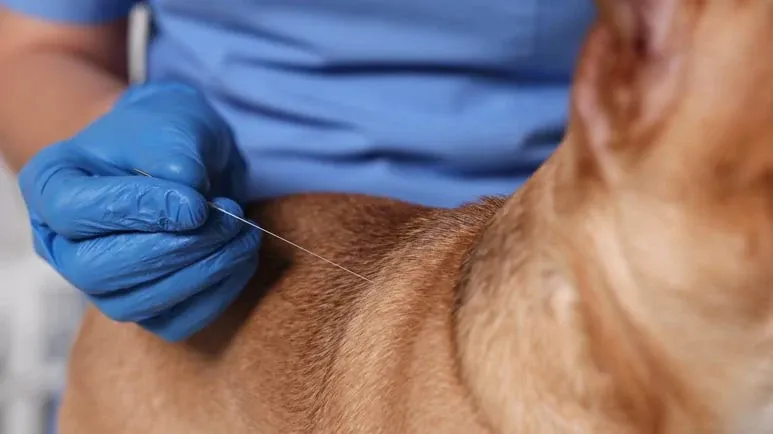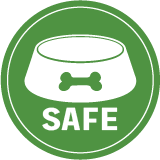The Ancient Therapy Transforming Your Pet's Well-Being
You've probably heard how this centuries-old technique helps ease pain, promote healing, and revive energy among humans, but did you know your pet can benefit from it, too?

STORY AT-A-GLANCE
- Pet acupuncture is a centuries-old therapy that uses fine needles placed at precise points to promote healing, reduce discomfort, and restore balance. It offers a valuable option alongside conventional veterinary treatments
- Acupuncture, rooted in ancient Chinese medicine, aims to unblock Qi ("chi") flowing along body meridians, like fixing a disrupted circuit to revive your pet’s natural healing abilities
- Despite misconceptions, research supports acupuncture’s effectiveness for pain relief, enhanced mobility, and improved overall health. Many animals experience deep relaxation or even fall asleep during sessions
- Acupuncture helps soothe arthritis and allergies and aids neurological issues and behavioral concerns by targeting nerve bundles using carefully placed thin needles. This process triggers calming enzymes and facilitates your pet’s smooth movement and better mood
- Acupuncture sessions typically last around 20 minutes and cause minimal stress. Your vet will closely monitor your pet’s reactions, adjusting needles if needed to help them gradually regain agility, appetite, and overall contentment
In most cases, pet acupuncture is a therapy that pet parents turn to as a last resort when they’ve tried all sorts of conventional remedies and treatment options for their beloved companion yet do not see any noticeable improvements in their health. However, this alternative therapy isn’t entirely new; people have practiced it for thousands of years.
Many people initially find pet acupuncture strange therapy to many people, but interest in this practice has grown. This isn’t just a passing trend but an approach based on ancient methods adapted to modern veterinary care.
What Is Pet Acupuncture?
The practice of acupuncture involves inserting thin needles into specific points on your pet’s body — called meridians1 — to promote wellness. This type of therapy can be traced back to traditional Chinese medicine, which has been used for centuries on its people and animals. Ancient healers believed that energy flowed through the body along specific routes. This energy is often called Qi, pronounced "chi."
When Qi moves freely, the body stays in a state of balance and health. But if it becomes blocked, discomfort or disease can occur. Think of Qi as the electric wiring in a home; if one circuit becomes disrupted, it may affect the power in the entire house. Acupuncture aims to fix those blockages so the body can heal. It’s like tapping into your pet’s natural healing process to address different ailments effectively.
Today, many integrative veterinarians have merged this ancient wisdom with contemporary science. They use sterilized needles, apply precise techniques, and rely on their scientific understanding of anatomy to determine the placement and positioning of the needles. Most of the time, acupuncture is used as a part of a comprehensive treatment plan and can be employed for a variety of purposes — from alleviating arthritis discomfort to easing allergies and even managing behavioral issues.2
Debunking Common Myths About Pet Acupuncture
Despite existing for a long time, a lot of people still have their doubts about the effectiveness of acupuncture. There are also numerous myths surrounding this therapy, leading pet parents to miss out on its healing advantages. An article from Yankee Hill Veterinary Hospital lists a few myths surrounding acupuncture (and the reality about them):3
- Acupuncture is an invasive treatment — Many people immediately picture large needles painfully stabbing their beloved pet’s skin when they hear about acupuncture. However, this is very far from the truth. Very thin needles are used, and the process is gentle and causes minimal stress.
- It’s painful for pets — Acupuncture is a relaxing process that causes minimal distress. Some dogs undergoing this treatment even fall asleep, meaning they’re not in pain.
- No one knows if it works — The reality is that there are numerous published studies on the effects of acupuncture on companion animals, and many of them highlight its promising effects.
For example, a 2016 study published in the Canadian Veterinary Journal found that a combination of acupuncture and manual therapy provides "immediate short-term improvement in comfort and mobility" in dogs with naturally occurring lameness.4
A year later, the same journal published another study, this time noting how acupuncture alone or in combination with pain-relieving drugs helped reduce pain and improve the quality of life of dogs with neurological and musculoskeletal diseases.5 - Acupuncture only relieves pain — As mentioned, it has been found to ease allergies and arthritis and may even help with behavioral issues in dogs.
"Acupuncturists who specialize in pet care undergo extensive training to master delicate techniques tailored for animals. These professionals ensure each session is calming and positive, using soft handling and comfort measures throughout the treatment," the article explains.
"This therapy taps into the body’s natural healing processes and isn’t limited to one benefit. Each needle placement is designed to help rebalance your dog’s vital energy force or chi, promoting better health across multiple systems within the body," the Yankee Hill Veterinary Hospital article reports.
How Does Acupuncture Work?
Acupuncture sessions are usually quick, around 20 to 30 minutes. In some clinics, the initial treatment is shorter, around 10 minutes, as it allows your pet to acclimate to the treatment. The number of sessions that your pet needs will depend on the health condition being treated.6
During the procedure, your vet carefully inserts tiny needles, (much thinner than the needles used in vaccines) It’s into specific points on your pet’s body. Many pets can feel the needles inserted, but the process doesn’t hurt them since these points contain nerve bundles and blood vessels. Stimulation triggers the release of pain-easing and calming enzymes to be released.
Throughout the session, your vet will monitor your pet’s reaction carefully. Some animals relax so thoroughly that they might show signs of deep calm, such as yawning, stretching, or falling asleep. Others may seem more alert but remain quiet and still.
While mild discomfort can happen at first, it usually goes away quickly. The practitioner can adjust the placement or remove specific needles if your pet appears uneasy. The environment also matters. If the room is calm and free from loud noises or other stressors, your pet is more likely to have a soothing experience. You might notice that your pet seems a bit sleepy afterward, which is a normal side effect.
Over time, as your pet undergoes more and more sessions, you’ll see them moving more smoothly, feeling less stiff, and even regaining some of their playful spirit. Often, the mood lift that comes with less pain can be just as important for an animal’s overall happiness as the direct relief from aches. Other areas of health that acupuncture may help include:7
- Seizures
- Osteoarthritis
- Hip dysplasia
- IVDD (Intervertebral disc disease)
- Degenerative myelopathy
- Metabolic disorders
- Acral lick dermatitis
To track your pet’s progress, you can keep a small journal and take note of changes in their mobility, appetite, or general mood. If your vet suggests follow-up sessions, those are a few days or weeks apart, depending on your pet’s condition.
Sources and References
- 1,2,3 Yankee Hill Veterinary Hospital, Debunking Common Misconceptions About Dog Acupuncture
- 4 Can Vet J. 2016 Apr;57(4):407-14
- 5 Can Vet J. 2017 Sep;58(9):941–951
- 6 VOMC, Acupuncture for Mobility Disorders
- 7 Animal Hospital of Padre Island, Acupuncture for Pets: An Alternative Therapy for Chronic Conditions










